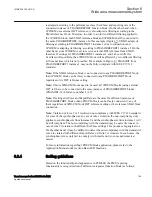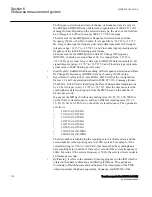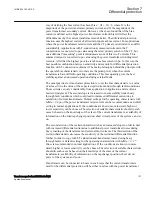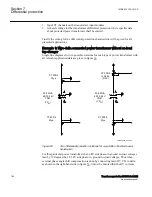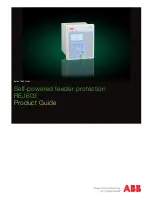
External faults happen ten to hundred times more often than internal ones as far as the
power transformers are concerned. If a disturbance is detected and the internal/external
fault discriminator characterizes this fault as an external fault, the conventional
additional criteria are posed on the differential algorithm before its trip is allowed. This
assures high algorithm stability during external faults. However, at the same time the
differential function is still capable of tripping quickly for evolving faults.
The principle of the internal/external fault discriminator can be extended to
autotransformers and transformers with three windings. If all three windings are
connected to their respective networks then three directional comparisons are made,
but only two comparisons are necessary in order to positively determine the position of
the fault with respect to the protected zone. The directional comparisons which are
possible, are: W1 - (W2+W3) and W2 - (W1+W3). The rule applied by the internal/
external fault discriminator in case of three-winding power transformers is:
•
If any comparison indicates an internal fault, then it is an internal fault.
•
If any comparison indicates an external fault, then it is an external fault
If one of the windings is not connected, the algorithm automatically reduces to the two-
winding version. Nevertheless, the whole power transformer is protected, including the
non-connected winding.
7.1.3.7
On-line compensation for on-load tap-changer position
M15266-326 v5
The Transformer differential function in the IED has a built-in facility to on-line
compensate for on-load tap-changer operation. The following parameters which are set
under general settings are related to this compensation feature:
•
Parameter
LocationOLTC1
defines the winding where first OLTC (OLTC1) is
physically located. The following options are available:
Not Used / Winding 1 /
Winding 2 / Winding 3
. When value
Not Used
is selected the differential function
will assume that OLTC1 does not exist and it will disregard all other parameters
related to first OLTC
•
Parameter
LowTapPosOLTC1
defines the minimum end tap position for OLTC1
(typically position 1)
•
Parameter
RatedTapOLTC1
defines the rated (for example, mid) position for
OLTC1 (for example, 11 for OLTC with 21 positions) This tap position shall
correspond to the values for rated current and voltage set for that winding
•
Parameter
HighTapPsOLTC1
defines the maximum end tap position for OLTC1
(for example, 21 for OLTC with 21 positions)
•
Parameter
TapHighVoltTC1
defines the end position for OLTC1 where highest no-
load voltage for that winding is obtained (for example, position with maximum
number of turns)
•
Parameter
StepSizeOLTC1
defines the voltage change per OLTC1 step (for
example, 1.5%)
1MRK 504 163-UUS A
Section 7
Differential protection
Transformer protection RET670 2.2 ANSI
143
Application manual
Summary of Contents for RELION RET670
Page 1: ...RELION 670 SERIES Transformer protection RET670 Version 2 2 ANSI Application manual ...
Page 2: ......
Page 48: ...42 ...
Page 64: ...58 ...
Page 74: ...68 ...
Page 104: ...98 ...
Page 194: ...188 ...
Page 518: ...512 ...
Page 618: ...612 ...
Page 648: ...642 ...
Page 666: ...660 ...
Page 672: ...666 ...
Page 682: ...676 ...
Page 844: ...838 ...
Page 868: ...862 ...
Page 956: ...950 ...
Page 964: ...958 ...
Page 1004: ...998 ...
Page 1014: ...1008 ...
Page 1015: ...1009 ...

